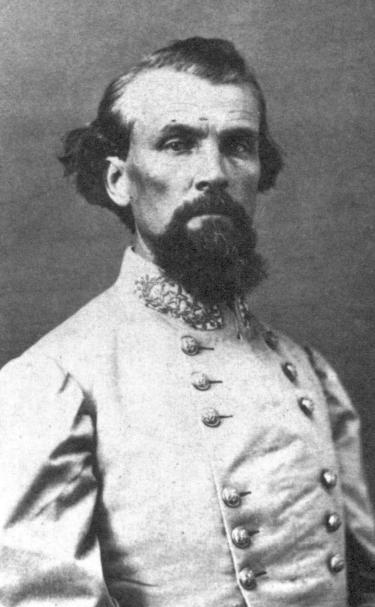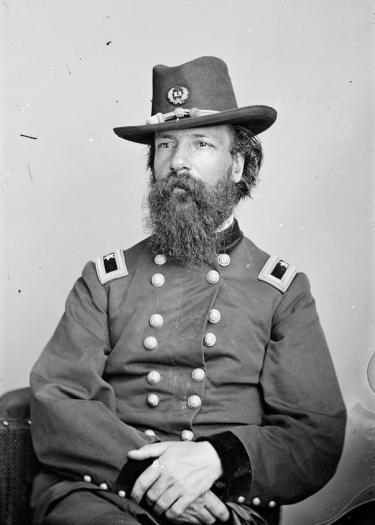The Battle of Parker's Cross Roads: Then & Now

The Civil War Trust recently had the chance to talk with Parker's Crossroads native and Tennessee Representative Steve McDaniel about the Battle of Parker's Cross Roads and the preservation challenges at this 1862 Tennessee battlefield.
Civil War Trust: Rep. McDaniel, tell us more about how you came to be interested in the American Civil War and the Battle of Parker’s Cross Roads.

Steve McDaniel: I grew up about a mile from the battlefield at Parkers Crossroads. (I am a seventh generation descendant living in this region of Tennessee.) When I was about seven years old I found my first relic of the period, a 19th Century pistol. My great uncle, a WWI veteran, told me I had found an old pistol from the “Civil War.” I guess this impressed me at this young age and I began to pay more attention as I grew older to the history of the war and particularly the Battle of Parkers Crossroads. There has been a Tennessee Historical Commission marker on the battle site prior to my childhood which I would read and wonder about this battle. It was when as a college student I began to research the battle using the OR’s. I had read the biographies of General N. B. Forrest over the years and was greatly fascinated by the man and his tactics.
It’s interesting to learn that the Battle of Parker’s Cross Roads in Western Tennessee was tied to the larger Vicksburg Campaign in Mississippi. How so?
SD: By December, 1862, Grant having cleared all of West Tennessee of organized Confederate occupation, made his move to open the Mississippi River to traffic from Memphis south to the Gulf. The western region in Tennessee from Memphis to Nashville was now occupied by federal forces.
Grant was moving troops and supplies by rail from Kentucky south through West Tennessee to Holly Springs, Mississippi, and beyond. Grant had moved his army as far south as Oxford, Mississippi, when “Forrest’s First West Tennessee Raid” took place.
Parker’s Cross Roads is known as one of Nathan Bedford Forrest’s key battles. What sort of force did Forrest have with him at Parker’s?

SD: Forrest was ordered by Gen. Braxton Bragg to leave Columbia, Tennessee, on Dec. 11, 1862, to destroy Grant’s supply line through West Tennessee from Kentucky to the Mississippi border. Bragg had left Forrest with mostly raw recruits who were armed with hunting rifles and shot guns. Recruiting more men on the campaign plus being joined by Col. Alonzo Napier and his 300 troopers brought Forrest’s force to near 1,800 men during the battle. Having captured two steel Rodman’s in Lexington his artillery numbered about ten pieces. His men were now armed with the best small arms, including uniforms, and other equipage the Federal army could afford him.
Tell us more about the Federal forces at Parker’s Cross Roads and what their strategic objective was.
Gen. J. C. Sullivan, commander of the West Tennessee federal forces, learned of Forrest’s crossing of the Tennessee River into West Tennessee on December 17, 1862. Federal estimates ran as high as 10,000 rebels under the command of Forrest when the maximum number of men was actually less than 1,800. Grant had ordered various federal regiments sent by rail north from Mississippi to track down Forrest. Col. Cyrus L. Dunham of the 50th Indiana Volunteer Infantry commanded the forces that met Forrest at Parker's Crossroads on the morning of Dec. 31st. Col. John W. Fuller commanded the Federal brigade that came in behind Forrest later in the battle and which had Forrest caught between two opposing forces each roughly the size of his own.

While attempting to negotiate the surrender of one Federal brigade, how was it that Forrest’s force failed to detect the second brigade now threatening the Confederate rear?
SM: Early on the morning of the battle Forrest ordered his brother Capt. William Forrest and a company of scouts north in the direction of Huntingdon to warn him of any approach of federal regiments in his rear. There exist no account I have read that tells us what happened to this band of scouts. Apparently they either took the wrong road or came back and joined the fighting before the arrival of the Ohio Brigade commanded by Col. John W. Fuller.
The famous Forrest quote from this battle is “Charge ’em both ways.” Can you help add some context and detail around this quote?
SM: Forrest had pushed the Federals south of the crossroads and after considerable amount of fighting the firing ceased. Twice Forrest sent a flag of truce asking Col. Dunham for an unconditional surrender and each time Dunham refused. Dunham told the last courier, “You get away from me with that flag and tell the General if he can take me to come and try.” About this same time firing could be heard in Forrest rear. The General could not believe that he had enemy in his rear without warning. After being told of the Federal advance he rode out to an area near Rev. John Parker’s house to see for himself. It was then that Forrest was held at gunpoint by one of the Federal soldiers who demanded his surrender. Forrest said he had already surrendered and that his men were getting ready form up and stack arms near the woodpile at Parker’s house. Following this episode, Col. Charles Carroll rode up to Forrest and asked him what to do. Forrest replied, “We’ll charge ’em both ways.” Forrest then rode off and began gathering up a small band of 75 to 125 men for the charge. When he came to Sgt. Nat Baxter, who was manning his mountain howitzer on the ridge in front of Dunham’s line, Forrest told him to fall in for the charge. Baxter told the General he had neither pistol nor sword. The General said that it was okay he wanted to make as big a show as possible.

Why is Parker’s Cross Roads considered a Confederate victory? Didn’t Forrest lose almost twice the number of men that the Federals did?
SM: Forrest lost 300 men captured when they were left on foot as Forrest made his hasty escape. Many of the Confederate horses had fallen into the hands of the unexpected Ohio Brigade. Forrest was able to leave the field with most of his wagons loaded with captured supplies, his artillery, with exception of one piece which had exploded during the fight, horses and mounted soldiers. The Federals did not pursue him from the field. They arranged themselves in a line of battle facing the east believing Forrest would make an attack on them from that direction the next morning. Little did they know that by sunrise the next day Forrest would be well on his way to crossing the Tennessee River at Clifton, where his West Tennessee raid began, escaping safely back into Middle Tennessee.
You have played an instrumental part in helping to save much of the Parker’s Cross Roads battlefield. What sort of modern threats has the battlefield faced? Are there still significant threats today?
SM: Parkers Crossroads is traversed east and west by Interstate 40 and north and south by State Route 22, being located midway between Memphis and Nashville. The town has grown considerably since the interstate highway opened in the late 1960’s. Developers and investors are constantly looking at this area for business development. We’ve been fortunate to save as much core battlefield as we have before the land is turned into parking lots. The tract that the Civil War Trust is working to save now is the “keystone tract” to all the land we’ve saved thus far. It was on this 52 acre tract where most of the Confederate artillery was located. If this land falls into the hands of commercial developers, the ability to interpret the battlefield in a meaningful way is lost.

How does the Parker’s Cross Roads battlefield compare to its 1862 state? And what can a visitor see at the battlefield today.
SM: Most of the land at Parkers Crossroads is still open area having been cultivated or forested since the war. Housing development and commercial business development have taken a considerable amount of land. We’re fortunate that most of the core battlefield has thus far escaped the developers. Families who owned the farms have left the property to their heirs who no longer feel the attachment felt by the previous owners. Now the land is going up for sale. As the economy improves so will likelihood of land sales.
Since 2001, 298 acres have been preserved to makeup the current battlefield park. Title to the property is held by the State of Tennessee and managed under contract by the City of Parkers Crossroads. There are over two miles of paved walking trails with interpretative signs. A ten mile self-guided driving tour with waysides and an audio CD is available which gives the visitor a more detailed understanding of the battle that took place at Parkers Crossroads on December 31, 1862. The city recently opened a new Visitor Center where one can get information on the battle and speak with knowledgeable hosts. The Visitor Center is also the location of a gateway marker on the Tennessee Civil War Trails network.
As the District 72 representative to Tennessee’s General Assembly, what role do you see the state playing during the 150th anniversaries of the American Civil War?
SM: Three years ago Gov. Phil Bredesen appointed the Tennessee Civil War Sesquicentennial Commission. The governor also awarded the Tennessee Department of Tourist Development two grants to build the Tennessee Civil War Trails system as five other states now have. Our current governor, Bill Haslam, has continued to fund and support the Tennessee Sesquicentennial Commission including the expansion of the Tennessee Civil War Trails program. The Tennessee General Assembly, even in these tough economic times and tight budgets, are funding projects by the Commission.
Learn More: Parker's Cross Roads
Steve McDaniel grew up in Henderson County, Tennessee, and is a graduate of the University of Memphis. Steve has been a small business owner for the past 30 years and was President of the Henderson County Chamber of Commerce for two terms. In addition, he has had a long and distinguished career as a public servant. Currently, he is the City Manager for the City of Parkers Crossroads, and has been a member of the Tennessee General Assembly representing House District 72 since 1988. In this capacity, he was elected by his colleagues to serve in the Republican leadership, serving two terms as Caucus Chairman and three terms as House Minority Leader. Steve currently serves as Deputy Speaker. Steve has been the recipient of numerous awards, including the United Daughters of the Confederacy's Jefferson Davis Award; the Sons of Confederate Veterans' Robert E. Lee Award for Heritage Preservation and its Distinguished Service Medal; the Dr. Frank Vandiver Award presented by the Houston Civil War Roundtable in Houston, Texas; and the Civil War Trust’s State Leadership Award in 2002.
Very supportive of battlefield preservation efforts in Tennessee, Steve served four terms as president of the Tennessee Civil War Preservation Association. He was appointed by Governor Bredesen to the Tennessee Civil War Sesquicentennial Commission, which is planning for the commemoration of the 150th anniversary of the War Between the States. Steve is past president of the Henderson County Historical Society. He also served as the first president of the Parkers Crossroads Battlefield Association when organized in 1993, and currently serves the position of historian.
Related Battles
237
500


